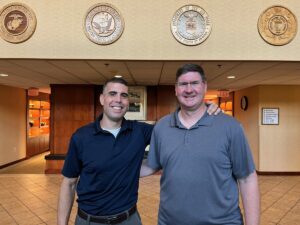
WASHINGTON (BP)–After his church invested $250,000 in wireless technology, Chris Hinkle of Prestonwood Baptist Church in Dallas is concerned by the federal government’s Aug. 21 vote to ban wireless microphones in the 700 megahertz band.
“There are 75 wireless microphones on our church’s property,” Hinkle, Prestonwood’s director of engineering, told Baptist Press. “The Federal Communications Commission’s decision to ban [wireless] microphones [from the 700 MHz band] greatly affects our church. On an average Sunday, 15,000 people attend services. Any time there are that many microphones in an area, you have to do a lot of frequency coordination.”
Wireless technology users and providers told Baptist Press they believe the FCC’s decision on wireless microphones, which are low-power auxiliary stations, will impact both large and small churches throughout the country.
The FCC, however, told BP that churches will not be affected by the ban because their wireless microphones will be able to operate within lower frequencies.
Companies such as Verizon Wireless and AT&T bought available spectrum, or unused bandwidth known as “white space,” from the FCC to utilize space in the 700 MHz band. According to a FCC report, wireless microphones and other low-power auxiliary stations that operate in spectrums other than the 700 MHz band will continue to be able to operate in additional spectrum bands in broadcasting TV channels below 700 MHz.
Chris Lyons, manager of technical and educational communications for the audio company Shure, also sees the FCC decision as taking a financial toll on churches, both large and small.
“Even though larger churches have a larger dollar investment at stake, they are better equipped to handle the situation,” Lyons said. “Small churches often rely on volunteer staffs, and many do not have the budget to purchase new equipment.”
The FCC decision is unreasonable for people who have spent millions of dollars on wireless equipment to operate within the 700 MHz band, Lyons said, and he is not alone in his opinion.
Bill Thrasher, president and principal consultant for Thrasher Design Group, said the FCC’s decision is simply unfair but has warned his clients to replace their wireless microphone systems in order to honor the requirements of the FCC to vacate the 700 MHz band.
Lyons said the FCC regularly requires wireless microphone users to get a license. Since the majority of microphone users do not, Lyons said the FCC’s Aug. 21 report on the issue remains inaccurate. The report said 156 low-power auxiliary station licenses out of 943 are currently authorized to operate in the 700 MHz band. Of those 156 licenses, only 30 will operate solely in the 614 though 806 MHz band, which is a part of the 700 MHz band.
Lyons said the big question is, “When do people need to stop using their microphones in the 700 MHz range?”
The FCC report said the proposed date is after the transition from analog to digital television on Feb. 17.
Lyons encouraged those affected by the ban to take inventory of all equipment, noting the three M’s of microphones: manufacturer, model number and MHz number. Lyons said the bandwidth number, labeled on either the back of the receiver or inside the transmitter, will determine within what MHz a microphone is located. If it lies within the 700 MHz range, he said it’s not possible to retune or remake the microphone.
“It’s cheaper to replace a microphone with a new unit, so you don’t have to exchange all the old parts with new ones,” Lyons said.
–30–
Elizabeth Wood is an intern with the Washington bureau of Baptist Press.














